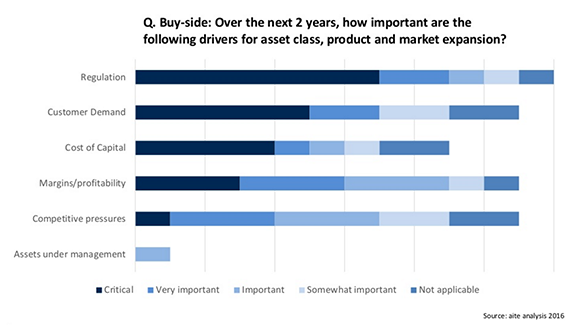
It’s no surprise that today’s asset managers are finding it harder to generate satisfactory investment returns. The fact is that unprecedented low yields, persistent competition and negative interest rates are huge hurdles impeding firms’ success.
These brutal trends have forced many institutions to investigate new and more diverse trading strategies that offer better yield possibility. In the last couple of years, we’ve seen more buy-side firms pursuing complex multi-asset investment strategies. These firms are increasingly entering new and emerging markets, since that is where the yield opportunity is tending to lie.
A recent Aite survey confirms the trend towards buy-sides embracing multi-asset investing. When Aite asked a sample of asset managers what factors were driving them towards trading multi-asset, the top three areas they identified were regulation, customer demand and the rising cost of capital, as reflected in the graph below.

Unfortunately, for many firms, expanding into new asset classes and products is not as simple as flipping a switch. Often legacy technology is a significant barrier to implementing more sophisticated strategies. These systems simply were not designed to handle multi-asset trading and thus are straining to adapt. For instance, often firms’ underlying analytics do not allow them to create the appropriate curves they need to enter new markets. And, while updating their legacy technology is always an option, it may not be the most efficient or cost-effective. The current marketplace is both tumultuous and changing at a rapid rate. To be competitive, buy-sides need access to flexible technology that enables them to respond quickly and nimbly to change.
Beyond performance concerns, buy-side firms face other significant pressures. Investors, regulators and even clients are requiring more transparency. Black box strategies are no longer acceptable. Not only is transparent valuation and reporting needed for regulatory compliance, but also transparency of risk and investment strategies (giving insight into why funds are performing or underperforming), are being demanded by clients and stakeholders. And since there are now more asset types now than ever that need to be managed and risk managed, technology that supports and offers full transparency of multi-asset portfolios is critical.
Luckily many solution providers have recently stepped up their game in this space. We’re seeing more vendors offering systems that provide the flexibility to quickly add new asset classes, currencies and complex structures. The best of these systems are easy to integrate with existing technology, provide transparency into all models, data and calculations, and enable access to consistent risk data across trading and risk management functions. Such advanced solutions also afford the freedom to trade what you want, where you want and how you want without needing to spend time and money updating systems each time you change up your strategy.
Our F3 portfolio and risk management solution has been designed with flexibility at its core. It enables you to represent the market in the way that you need, and take on any strategy you wish, now and in the future. Timely risk and performance data allow you to move from end of day to intraday and on-demand reporting, helping you make better investment decisions.
For more tips on how to thrive in a low-yield environment, watch the on-demand webinar: Thriving in a Low Yield World.

